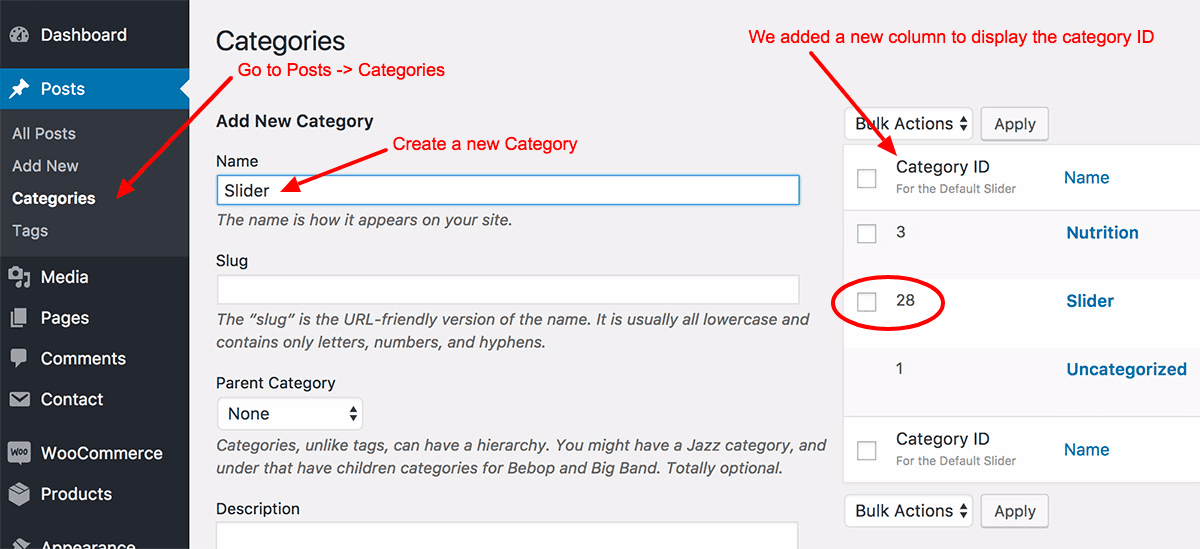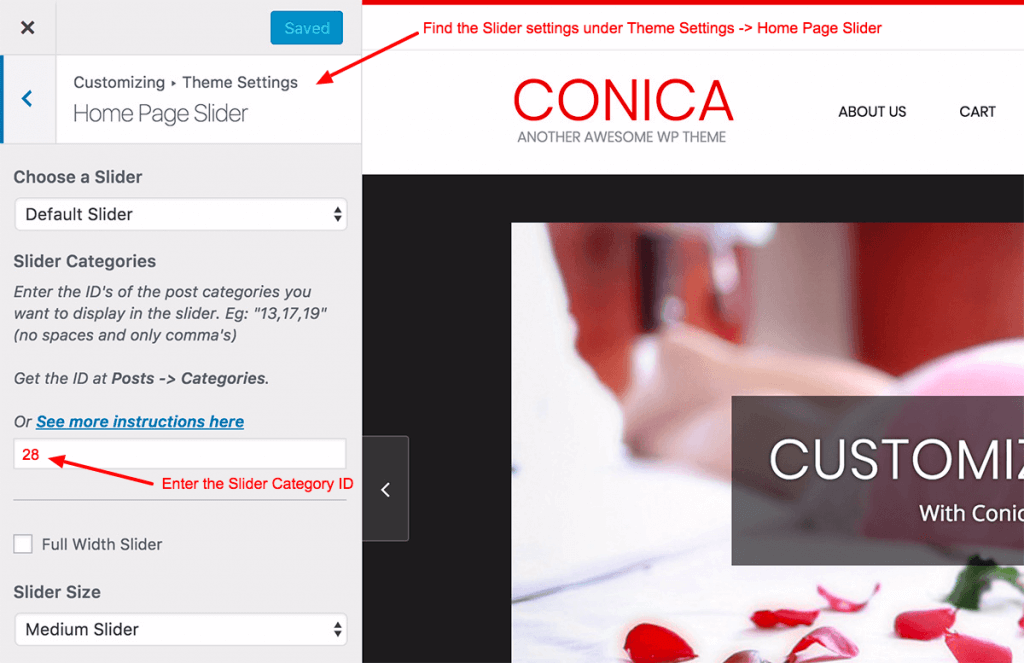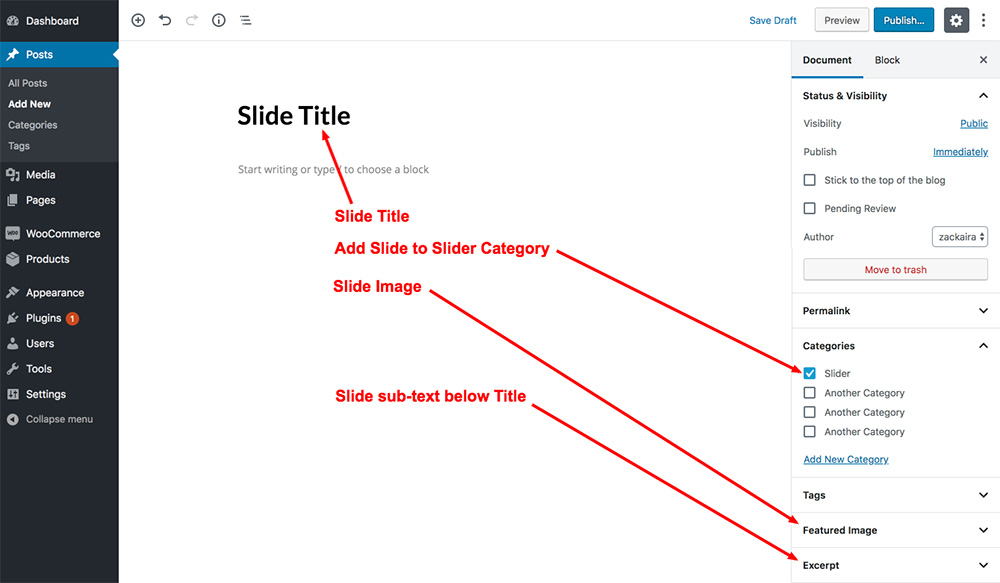Most of our themes come with 3 options when choosing a slider for your home page:
- The themes built in Default Slider
- The option to add any other slider via a shortcode.
- No Slider
This slider is on the following WordPress themes: Vogue, Avant, Guten, Sabino, TopShop, Nikkon & Conica.
Using the Theme default slider
The default slider options for the mentioned themes are built into the WordPress Customizer, there you will find 3 different options for the sliders.
Using the theme Default Slider
This slider is a very basic slider and it is only available on the home page of the themes it comes with.
1) Create a new post Category for the slider to use:
Start out by going to Posts -> Categories in the WordPress Dashboard and create a new category called Slider. You can use any other name you like, the important element here is the category ID which we display in the left column.

Once you add the name and click to Add New Category, you will see the new category appear in the list.
Now you can copy or just remember the Category ID, as you will paste this ID into the Slider settings so that the slider knows which Posts to use in the slider.
2) Add the Category ID to your slider settings in the Customizer:
Once you’ve created the category, you can then go to Customize -> Theme Settings -> Home Page Slider to implement & configure the slider… Please Note: The path might be slightly different, but should be close enough to find.
If you go to Customize -> Theme Settings -> Home Page Slider you will see a setting called Slider Categories… This is where you will enter the category ID of the new category that you created in the step before.

Now your default slider will know to use all the posts in the Slider category.
You can add multiple categories to show in the slider… adding multiple categories is done by simply comma ( , ) separating the category ID’s. Eg: 28, 4, 11
You will not see the slider yet, as we have not yet created any posts to be shown in the slider… The next step is this.
3) Create Slider posts for the slider:
The next step is to go to Posts -> Add New in your WordPress Dashboard and create a new post for the slider you’ve just set up.
For the new slide you need to add the following:
- Slide Title
- Featured Image
- Excerpt (adds extra text below the title)
- Tag the slide into the Slider category
- Premium offers an extra custom link box to specify custom links for each slide

To display the Slide Custom Link box on each slide you will need to select the Link Slide to post settings under the slider settings in the Customizer.
Once you’ve added the new post correctly, you will then see the default slider appear on your home page.
Adding one post/slide will display just as a banner image, once you add more posts/slides, it will then turn into a slider and slide between the different posts.
Under Customize -> Theme Settings ->Home Page Slider you will find extra settings for the Slider. You can change these settings to see exactly what they do before making the changes live. They are all pretty self explanatory.
4) (Optional) Remove the Slider posts from the blog list:
This setting is optional of course, but guessing that you don’t want the slider posts to show up in the blog list, you can simply add the slider category ID to the Exclude Blog Categories input which you will find under the Blog List settings in the Customizer.
Here you need to add the category ID with a minus before it.
Eg: -28

You can add multiple ID’s separated by a comma (,) with a minus to remove multiple categories from the blog list.
Or, if you add multiple ID’s, separated by a comma (,) without the minus sign, then the blog list will show only the posts in those categories.
Eg: 28, 17, 23, 48
Adding a shortcode Home Page Slider
Another option is to use the Shortcode slider option… This will require you to enter a shortcode that is provided by a Slider plugin you’ve added to your WordPress install.
We usually recommend Meta Slider or Smart Slider.
See our Recommended Resources for more recommendations.
No Slider
Otherwise you can completely remove the slider if you do not want to have it on your home page.
Simply select the option None.
Other Slider Options
The theme default slider works great and is a very neat, simple slider for WordPress, however, if you’re wanting to add more sliders within the page then we recommend looking in adding on these plugins which our themes are designed to work very well with.
Blockons
The Blockons plugin is an advanced tool for creating dynamic, professional WordPress websites using the code WordPress editor.
Packed with advanced blocks, it simplifies customization and elevates your site’s design without requiring coding skills.
Some highlights are the Advanced Sliders, Video Sliders, Testinomials Sliders, image galleries and carousel blocks all included with Blockons, and lots more all for FREE, perfect for showcasing products, visuals, or featured content. These responsive, customizable sliders offer multiple layouts, animations, and controls to create stunning, high-performing designs tailored to your needs.
With Blockons, you unlock endless creative possibilities to build a standout website effortlessly.
Elementor
Elementor Page Builder Pro version for $59 per year is a powerful, user-friendly tool for creating stunning website content without any coding knowledge.
With its intuitive drag-and-drop interface, Elementor allows you to design professional-looking pages quickly and efficiently. Packed with pre-designed templates and a wide range of widgets, you can easily add text, images, sliders, forms, and more. Its flexibility makes it ideal for building dynamic sliders, interactive content sections, and fully responsive pages that look great on any device.
Whether you’re a beginner or a seasoned developer, Elementor empowers you to create visually captivating websites with ease.




